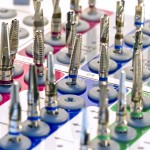
Dental Implants now in regular use in dental practice. However they come in an almost bewildering array of sizes and materials and with a range of surface characteristics and modifications. Many of these modifications have been developed with the aim of improving clinical performance. This update of a Cochrane review which was last refreshed in 2007 aimed to compare the clinical effects of different root-formed osseointegrated dental implant types for replacing missing teeth for the following specific comparisons:-
- implants with different surface preparations, but having similar shape and material;
- implants with different shapes, but having similar surface preparation and material;
- implants made of different materials, but having similar surface preparation and shape;
- different implant types differing in surface preparation, shape, material or a combination of these.
Standard Cochrane methodological approaches were followed with searches of the Cochrane Oral Health Group’s Trials Register, the Cochrane Central Register of Controlled Trials (CENTRAL) Medline and Embase without restrictions. Randomised control trials (parallel group or split mouth) with follow up of at least one year after functional loading were considered.
- 27 RCTs involving 1512 patients (3230 implants) were included.
- Follow up ranged from 1-10years.
- All implants were of commercially pure titanium or its alloys, and had different shapes and surface preparations.
- 2 trials were considered to be at low risk of bias 10 unclear and 15 at high risk.
- On a ’per participant’ rather than ’per implant’ basis, there were no significant differences between various implant types for implant failures.
- The only observed statistically significant difference for the primary objective regarded more peri-implant bone loss at Nobel Speedy Groovy implants when compared with NobelActive implants (MD -0.59 mm; 95% CI -0.74 to -0.44, different implant shapes).
- The only observed statistically significant difference for the secondary objective was that implants with turned (smoother) surfaces had a 20% reduction in risk to be affected by peri-implantitis than implants with rough surfaces three years after loading (RR 0.80; 95% CI 0.67 to 0.96).
- There was a tendency for implants with turned surfaces to fail early more often than implants with roughened surfaces.
The authors concluded
Based on the results of the included RCTs, we found no evidence showing that any particular type of dental implant had superior long- term success. There was limited evidence showing that implants with relatively smooth (turned) surfaces were less prone to lose bone due to chronic infection (peri-implantitis) than implants with much rougher surfaces (titanium-plasma-sprayed). These findings were based on several RCTs, often at high risk of bias, with few participants and relatively short follow-up periods.
Comment
Since the last version of this review the number of RCTs able to be included has increased from 16 to 27 although the authors highlight the fact that 81 potential RCTs were identified but a range of potential issues meant that they could not be included. They also note that 58% of the 27 included were funded by implant manufacturers, which is a potential source of bias.
Links
Esposito M, Ardebili Y, Worthington HV. Interventions for replacing missing teeth: different types of dental implants. Cochrane Database of Systematic Reviews 2014, Issue 7. Art. No.: CD003815. DOI: 10.1002/14651858.CD003815.pub4.

[…] Review found no evidence showing that any particular type of dental implant had greater long-term su… […]
[…] http://www.nationalelfservice.net/dentistry/restorative-dentistry/review-found-no-evidence-showing-t… […]